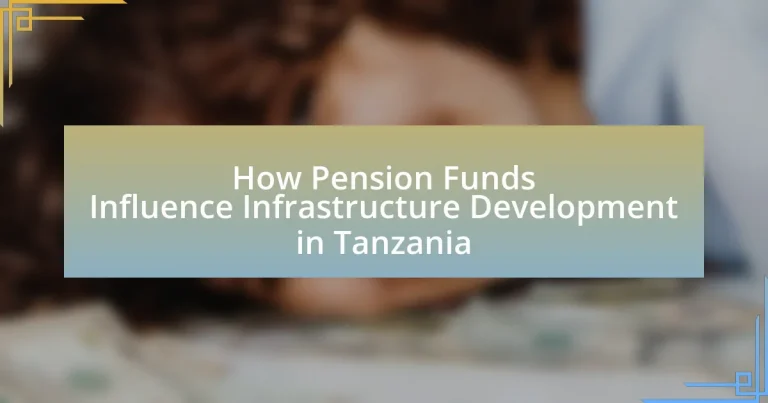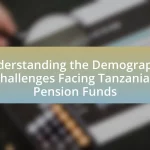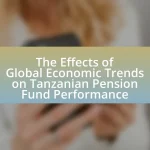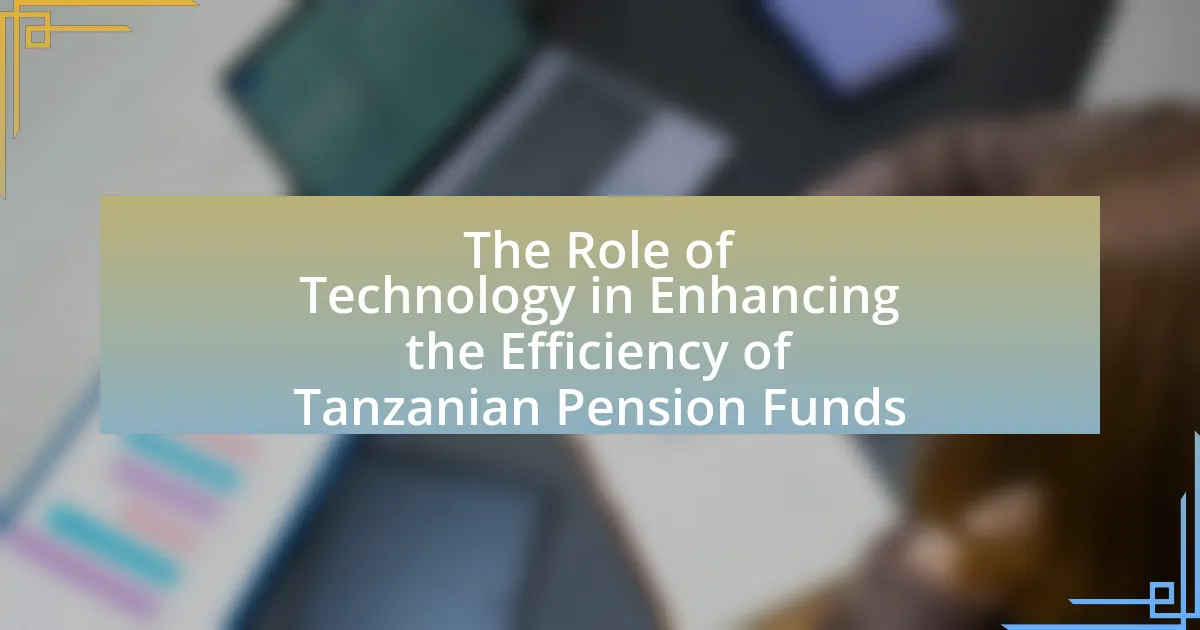Pension funds play a critical role in infrastructure development in Tanzania by providing essential long-term capital for projects such as roads, energy facilities, and water supply systems. The National Social Security Fund (NSSF) exemplifies this impact through its investments, which contribute to economic growth and job creation. The article explores how pension funds allocate resources, the types of infrastructure projects they typically fund, and the challenges faced in the sector, including regulatory hurdles and funding gaps. It also discusses the importance of public-private partnerships and the potential risks associated with these investments, highlighting strategies for mitigating risks and enhancing project outcomes through community engagement and sustainable practices.
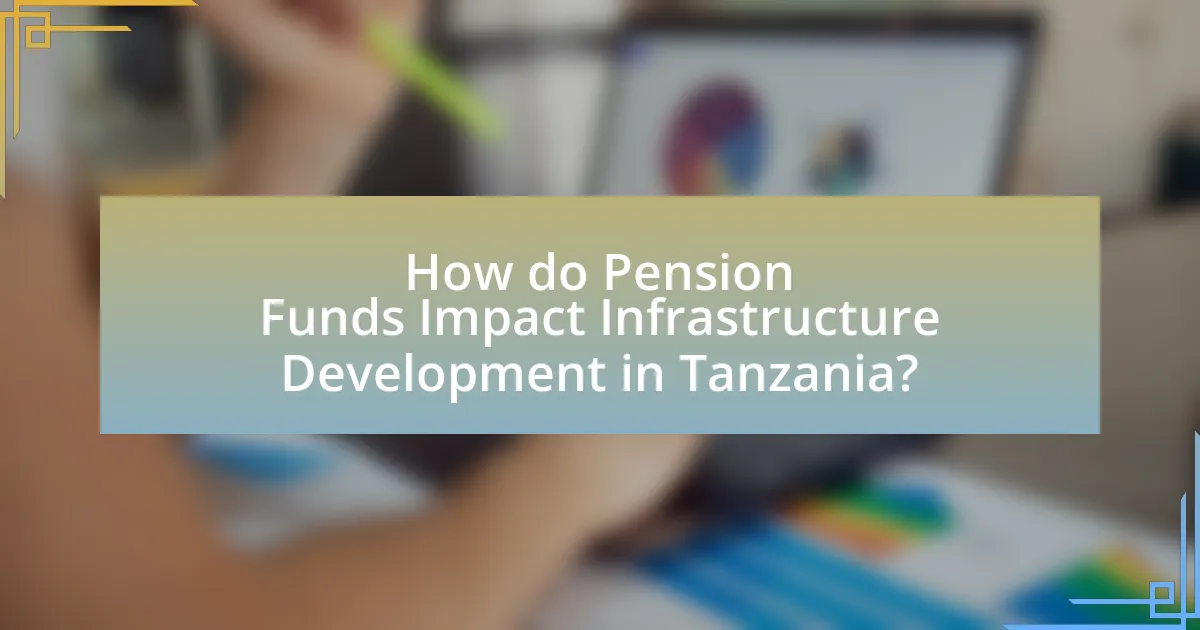
How do Pension Funds Impact Infrastructure Development in Tanzania?
Pension funds significantly impact infrastructure development in Tanzania by providing a stable source of long-term capital for large-scale projects. These funds, which manage the savings of workers, can invest in infrastructure such as roads, bridges, and energy facilities, thereby addressing the country’s infrastructure deficit. For instance, the National Social Security Fund (NSSF) in Tanzania has been involved in financing various infrastructure projects, contributing to economic growth and job creation. According to the World Bank, increased investment from pension funds in infrastructure can enhance public-private partnerships, leading to improved service delivery and economic resilience.
What role do pension funds play in financing infrastructure projects?
Pension funds play a crucial role in financing infrastructure projects by providing long-term capital that is essential for large-scale developments. These funds typically invest in infrastructure due to the stable, predictable cash flows that such projects can generate, which align with their long-term liabilities to beneficiaries. For instance, in Tanzania, pension funds have increasingly allocated resources to infrastructure, contributing to projects like roads, energy, and water supply systems, thereby enhancing economic growth and development. According to the World Bank, pension funds globally hold over $40 trillion in assets, indicating their significant potential to finance infrastructure, particularly in emerging markets like Tanzania where funding gaps exist.
How do pension funds allocate resources for infrastructure investments?
Pension funds allocate resources for infrastructure investments by diversifying their portfolios to include long-term assets that provide stable returns. These funds typically assess the risk-return profile of various infrastructure projects, focusing on sectors such as transportation, energy, and utilities, which are essential for economic growth. For instance, according to the Global Infrastructure Investor Survey, pension funds have increased their allocation to infrastructure from 5% to over 10% of total assets in recent years, reflecting a strategic shift towards stable, long-term investments. This allocation strategy is driven by the need for predictable cash flows and inflation protection, making infrastructure an attractive option for pension funds seeking to meet their long-term liabilities.
What types of infrastructure projects are typically funded by pension funds?
Pension funds typically fund infrastructure projects such as transportation systems, energy facilities, water supply and sanitation projects, and social infrastructure like schools and hospitals. These projects are attractive to pension funds due to their long-term investment horizons and stable cash flows. For instance, according to the Global Infrastructure Investor Survey, 70% of institutional investors, including pension funds, prioritize investments in transportation and energy sectors, reflecting their commitment to essential services that generate consistent returns.
Why are pension funds crucial for Tanzania’s infrastructure growth?
Pension funds are crucial for Tanzania’s infrastructure growth because they provide a stable source of long-term capital necessary for large-scale projects. These funds, which manage substantial assets accumulated from employee contributions, can be directed towards financing infrastructure developments such as roads, bridges, and energy facilities. For instance, the National Social Security Fund (NSSF) in Tanzania has invested in various infrastructure projects, demonstrating the potential of pension funds to support economic growth. By channeling investments into infrastructure, pension funds not only enhance the country’s physical assets but also contribute to job creation and economic stability, thereby reinforcing their importance in Tanzania’s development strategy.
What challenges does Tanzania face in infrastructure development?
Tanzania faces significant challenges in infrastructure development, primarily due to inadequate funding, poor planning, and regulatory hurdles. The country’s infrastructure needs are vast, with an estimated investment requirement of $14 billion annually to meet its development goals, yet funding sources remain limited. Additionally, inefficient project management and lack of skilled labor hinder timely execution of infrastructure projects. Regulatory challenges, including bureaucratic delays and inconsistent policies, further complicate the development process, leading to increased costs and project cancellations. These factors collectively impede Tanzania’s ability to enhance its infrastructure effectively.
How do pension funds address these challenges?
Pension funds address challenges in infrastructure development in Tanzania by diversifying their investment portfolios and collaborating with government entities. By investing in a mix of asset classes, pension funds mitigate risks associated with economic fluctuations and project-specific uncertainties. For instance, the National Social Security Fund (NSSF) of Tanzania has engaged in public-private partnerships to finance infrastructure projects, thereby leveraging both public resources and private sector efficiency. This approach not only enhances the financial viability of projects but also aligns with national development goals, as evidenced by the NSSF’s involvement in significant infrastructure initiatives like road and housing developments.
What are the potential risks associated with pension fund investments in infrastructure?
Pension fund investments in infrastructure carry several potential risks, including market risk, regulatory risk, and operational risk. Market risk arises from fluctuations in economic conditions that can affect the value of infrastructure assets, such as changes in interest rates or demand for services. Regulatory risk involves changes in laws or policies that can impact project viability or profitability, particularly in developing regions like Tanzania where regulatory frameworks may be less stable. Operational risk pertains to the challenges in managing infrastructure projects, including construction delays, cost overruns, and maintenance issues, which can lead to financial losses. These risks highlight the complexities pension funds face when investing in infrastructure, especially in emerging markets.
How can pension funds mitigate risks in infrastructure investments?
Pension funds can mitigate risks in infrastructure investments by diversifying their portfolios across various sectors and geographic regions. This strategy reduces exposure to any single investment’s failure, as evidenced by studies showing that diversified portfolios can lower volatility and enhance returns. Additionally, pension funds can engage in thorough due diligence and risk assessment processes, utilizing financial models and historical data to evaluate potential projects. Research indicates that funds employing rigorous risk management frameworks, such as those outlined by the International Finance Corporation, experience lower default rates in infrastructure investments. By combining diversification with comprehensive risk analysis, pension funds can effectively manage and reduce risks associated with infrastructure investments.
What lessons can be learned from past pension fund investments in Tanzania?
Past pension fund investments in Tanzania highlight the importance of regulatory frameworks and risk management. These investments have often faced challenges due to inadequate governance and lack of transparency, which led to suboptimal returns. For instance, the Tanzania Pension Fund Act of 2008 aimed to improve the investment climate, yet many funds struggled to diversify their portfolios effectively. Additionally, historical data indicates that investments in infrastructure projects yielded higher returns when aligned with national development goals, emphasizing the need for strategic planning. Thus, the lessons learned underscore the necessity for robust regulatory oversight and strategic alignment with national priorities to enhance the effectiveness of pension fund investments in driving infrastructure development.

What are the mechanisms through which pension funds influence infrastructure development?
Pension funds influence infrastructure development primarily through direct investment, public-private partnerships, and long-term financing. Direct investment allows pension funds to allocate capital to infrastructure projects, thereby providing necessary funding for construction and maintenance. Public-private partnerships enable pension funds to collaborate with governments and private entities, sharing risks and resources to enhance project viability. Long-term financing from pension funds supports infrastructure projects that require substantial upfront capital and offer stable, long-term returns, which aligns with the investment horizon of pension funds. For instance, in Tanzania, pension funds have been involved in financing road construction and energy projects, demonstrating their role in facilitating essential infrastructure development.
How do regulatory frameworks affect pension fund investments in infrastructure?
Regulatory frameworks significantly influence pension fund investments in infrastructure by establishing the rules and guidelines that govern investment practices. These frameworks dictate the types of assets pension funds can invest in, the risk levels they can assume, and the reporting requirements they must adhere to. For instance, in Tanzania, the Pension Reform Act outlines specific investment limits and mandates that a certain percentage of pension funds be allocated to infrastructure projects, thereby encouraging investment in this sector. This regulatory environment not only shapes the investment strategies of pension funds but also impacts the overall availability of capital for infrastructure development, as seen in the increased funding for projects like roads and energy facilities in the country.
What regulations govern pension fund investments in Tanzania?
The regulations governing pension fund investments in Tanzania are primarily outlined in the Pension Act of 2008 and the regulations issued by the Pension Fund Regulatory Authority (PPFRA). The Pension Act establishes the legal framework for the operation and management of pension funds, including investment guidelines that ensure funds are invested prudently and in a diversified manner. The PPFRA further issues specific regulations that dictate the types of assets in which pension funds can invest, including limits on investments in real estate, equities, and government securities. These regulations aim to protect the interests of pension fund members while promoting stability and growth in the financial sector.
How do these regulations impact the flow of capital into infrastructure projects?
Regulations significantly influence the flow of capital into infrastructure projects by establishing the legal framework and investment guidelines that govern pension funds. In Tanzania, specific regulations dictate how pension funds can allocate their assets, often requiring a portion of investments to be directed towards infrastructure development. For instance, the Pension Funds Act mandates that a minimum of 30% of pension fund assets be invested in government securities and infrastructure projects, thereby channeling substantial capital into these sectors. This regulatory requirement not only ensures a steady flow of funds into infrastructure but also mitigates risks associated with investment diversification, ultimately enhancing the capacity for large-scale infrastructure development in Tanzania.
What partnerships exist between pension funds and government entities?
Partnerships between pension funds and government entities in Tanzania primarily focus on infrastructure development projects. These collaborations often involve pension funds investing in public-private partnerships (PPPs) to finance essential infrastructure such as roads, energy, and housing. For instance, the National Social Security Fund (NSSF) of Tanzania has engaged in partnerships with the government to develop housing projects, which not only provide returns for the pension fund but also address the housing deficit in the country. Additionally, pension funds may collaborate with government entities to create investment vehicles that pool resources for large-scale infrastructure initiatives, thereby enhancing economic growth and stability.
How do public-private partnerships enhance infrastructure development?
Public-private partnerships (PPPs) enhance infrastructure development by leveraging the strengths of both sectors to deliver projects more efficiently and effectively. These collaborations combine public sector oversight and regulatory frameworks with private sector innovation, capital, and operational expertise, resulting in improved project delivery timelines and cost management. For instance, a study by the World Bank indicates that PPPs can reduce project costs by 20% to 30% compared to traditional public procurement methods. Additionally, PPPs often attract foreign investment, which can further stimulate local economies and infrastructure growth.
What are the benefits of collaboration between pension funds and the government?
Collaboration between pension funds and the government enhances infrastructure development by pooling resources and expertise. This partnership allows for increased investment in large-scale projects, which can lead to improved public services and economic growth. For instance, in Tanzania, pension funds can provide significant capital for infrastructure projects, while the government can facilitate regulatory support and risk mitigation. This synergy not only accelerates project timelines but also ensures that investments align with national development goals, ultimately benefiting both the economy and the citizens.
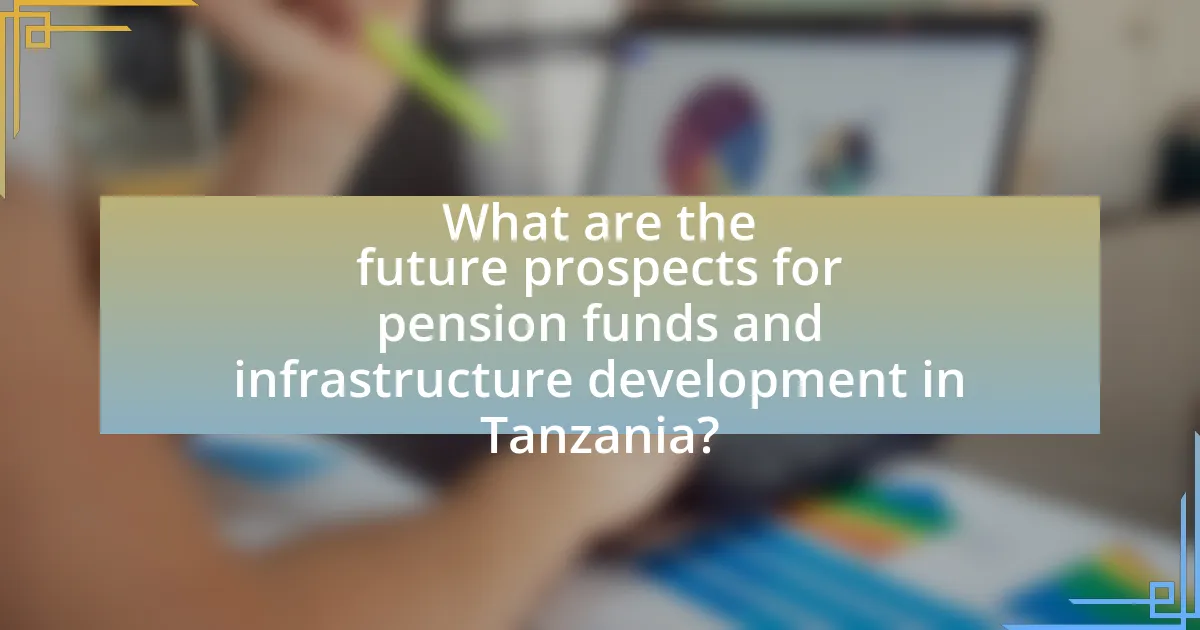
What are the future prospects for pension funds and infrastructure development in Tanzania?
The future prospects for pension funds and infrastructure development in Tanzania are promising, driven by increasing government initiatives and regulatory frameworks that encourage investment in infrastructure. The Tanzanian government has prioritized infrastructure development, with plans to invest approximately $14 billion in projects such as roads, railways, and energy facilities over the next few years. This creates a conducive environment for pension funds, which are seeking stable, long-term investment opportunities.
Moreover, the National Social Security Fund (NSSF) has been actively engaging in infrastructure projects, demonstrating the potential for pension funds to play a significant role in financing development. As of 2023, pension funds in Tanzania have begun to allocate a portion of their portfolios to infrastructure, reflecting a growing trend in emerging markets where pension funds are increasingly viewed as a source of capital for public projects. This shift is supported by the need for improved infrastructure to stimulate economic growth and attract foreign investment, thereby enhancing the overall investment landscape for pension funds in Tanzania.
How can pension funds adapt to changing economic conditions in Tanzania?
Pension funds in Tanzania can adapt to changing economic conditions by diversifying their investment portfolios and increasing allocations to infrastructure projects. Diversification helps mitigate risks associated with economic fluctuations, while infrastructure investments can provide stable, long-term returns. For instance, the National Social Security Fund (NSSF) has invested in various infrastructure projects, such as roads and energy, which not only generate returns but also support national development goals. This strategic approach allows pension funds to remain resilient during economic downturns and capitalize on growth opportunities in the infrastructure sector.
What trends are emerging in the infrastructure sector that may affect pension funds?
Emerging trends in the infrastructure sector that may affect pension funds include increased investment in renewable energy, a focus on sustainable infrastructure, and the integration of technology in construction and maintenance. The shift towards renewable energy is driven by global climate commitments, with investments in solar and wind projects expected to grow significantly, potentially offering stable returns for pension funds. Additionally, sustainable infrastructure projects are gaining traction as governments and private entities prioritize environmentally friendly developments, which can align with pension funds’ long-term investment strategies. The integration of technology, such as smart infrastructure and digital project management tools, enhances efficiency and reduces costs, making infrastructure investments more attractive to pension funds. These trends indicate a transformative shift in the infrastructure landscape, presenting both opportunities and challenges for pension fund investments.
How can pension funds leverage technology to improve infrastructure investments?
Pension funds can leverage technology to improve infrastructure investments by utilizing data analytics and digital platforms for better decision-making and risk assessment. Advanced data analytics allows pension funds to analyze large datasets related to infrastructure projects, enabling them to identify trends, assess project viability, and optimize investment strategies. For instance, the use of Geographic Information Systems (GIS) can enhance site selection and project planning by providing detailed spatial analysis. Additionally, blockchain technology can improve transparency and security in transactions, reducing fraud and increasing investor confidence. A report by McKinsey highlights that technology adoption in investment processes can lead to a 20-30% increase in efficiency, demonstrating the tangible benefits of integrating technology into infrastructure investment strategies.
What best practices should pension funds follow to maximize their impact on infrastructure development?
Pension funds should prioritize long-term investment strategies, collaborate with government entities, and engage in public-private partnerships to maximize their impact on infrastructure development. Long-term investment strategies allow pension funds to align their financial goals with the extended timelines typical of infrastructure projects, ensuring sustainable returns. Collaboration with government entities facilitates access to critical information and resources, enhancing project feasibility and alignment with national development goals. Engaging in public-private partnerships leverages private sector efficiency and innovation, which can lead to more effective infrastructure solutions. For instance, the World Bank reports that effective public-private partnerships can reduce project costs by up to 30%, demonstrating the potential for increased impact through strategic collaboration.
What strategies can pension funds implement to ensure sustainable investments?
Pension funds can implement strategies such as integrating Environmental, Social, and Governance (ESG) criteria into their investment processes to ensure sustainable investments. By adopting ESG frameworks, pension funds can assess the sustainability and ethical impact of their investment choices, which is increasingly important as investors demand responsible stewardship of capital. Research indicates that companies with strong ESG practices often outperform their peers financially, demonstrating that sustainable investments can yield competitive returns. For instance, a study by the Global Sustainable Investment Alliance reported that global sustainable investment reached $35.3 trillion in 2020, reflecting a 15% increase over two years, highlighting the growing trend and potential profitability of sustainable investment strategies.
How can pension funds engage with local communities to enhance project outcomes?
Pension funds can engage with local communities by actively involving them in the planning and decision-making processes of infrastructure projects. This engagement can lead to better alignment of projects with community needs, ultimately enhancing project outcomes. For instance, when pension funds conduct community consultations and incorporate feedback, they can identify specific local priorities, which increases the likelihood of project acceptance and success. Research indicates that projects with community involvement tend to have higher satisfaction rates and lower resistance, as seen in various infrastructure initiatives across Africa, including Tanzania.
